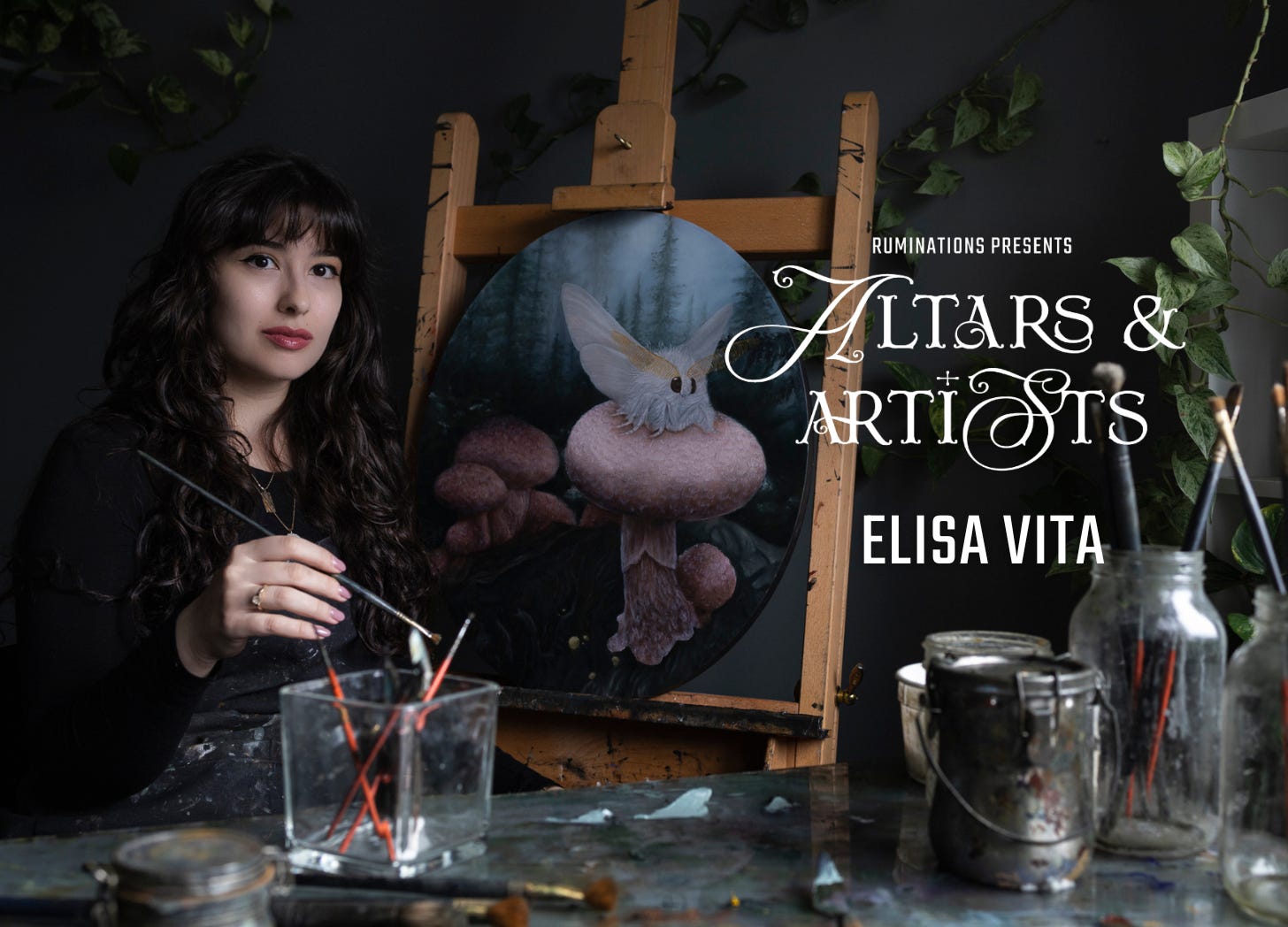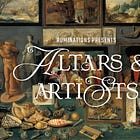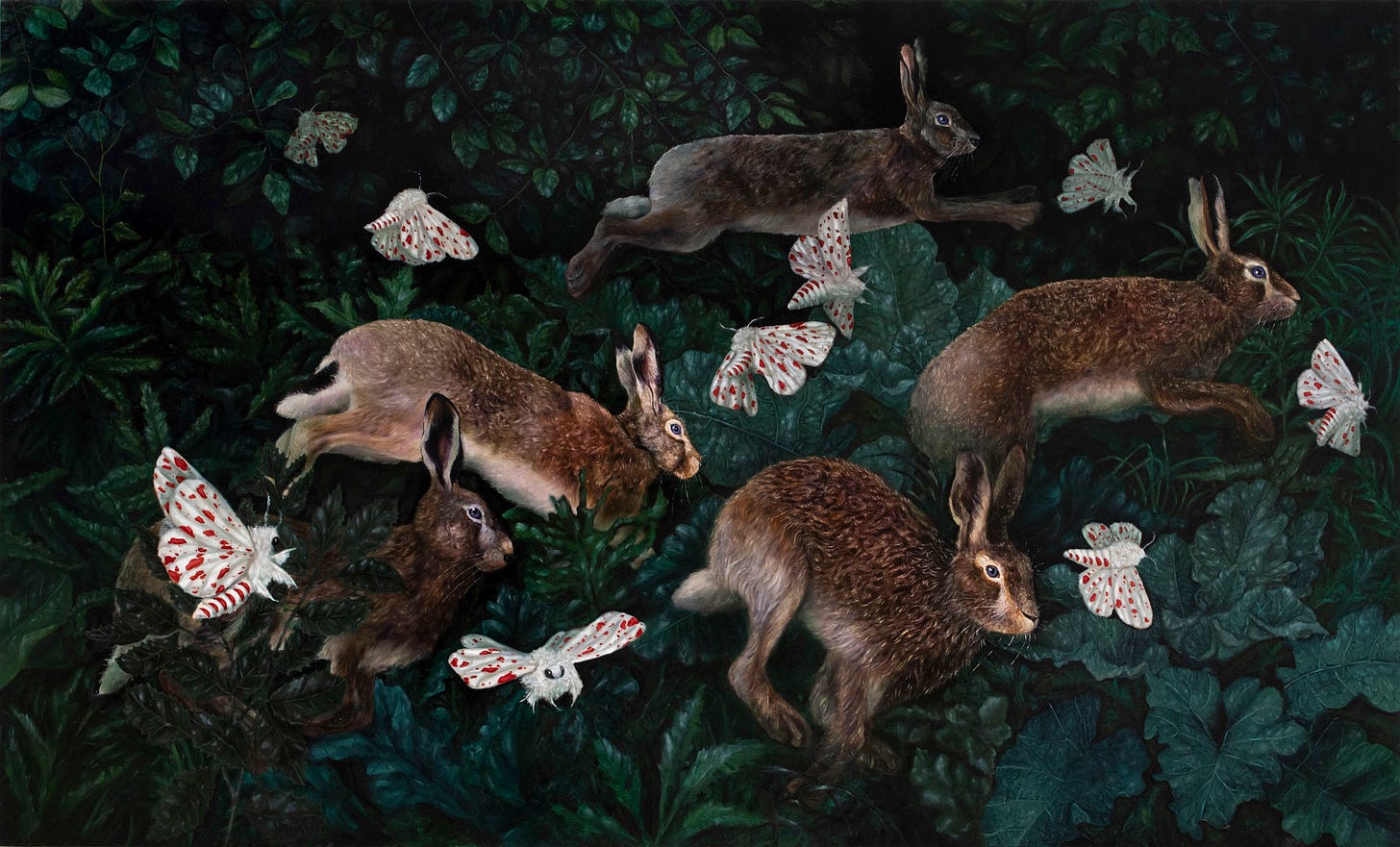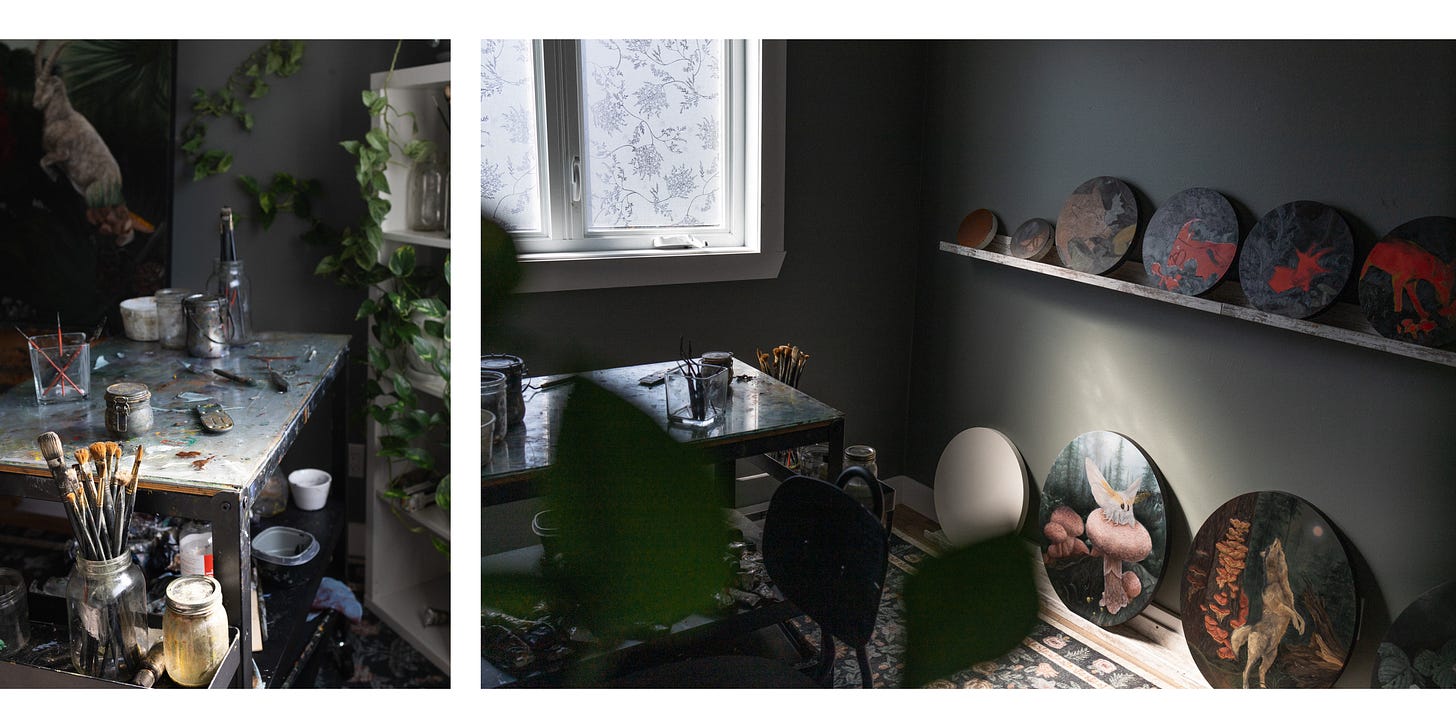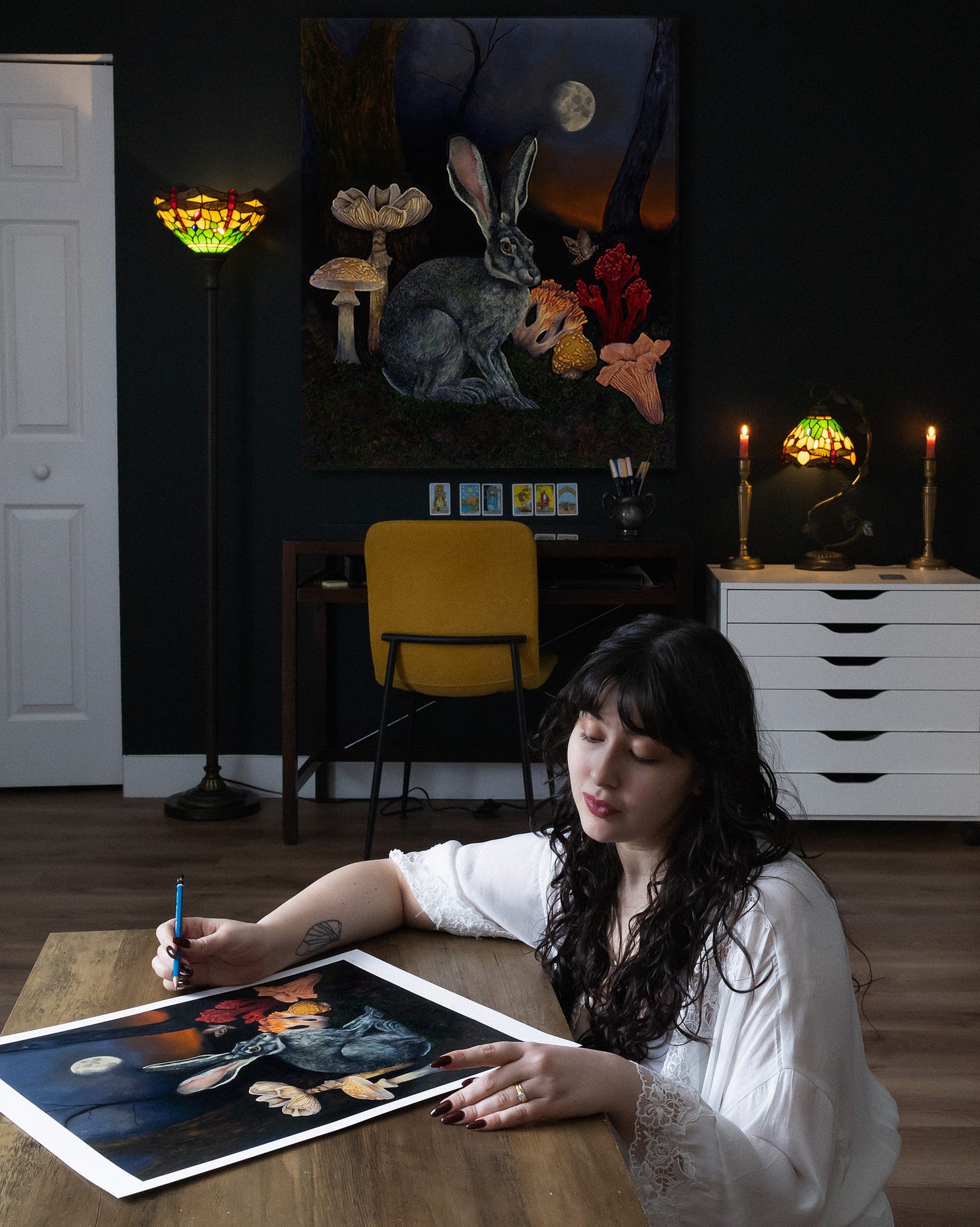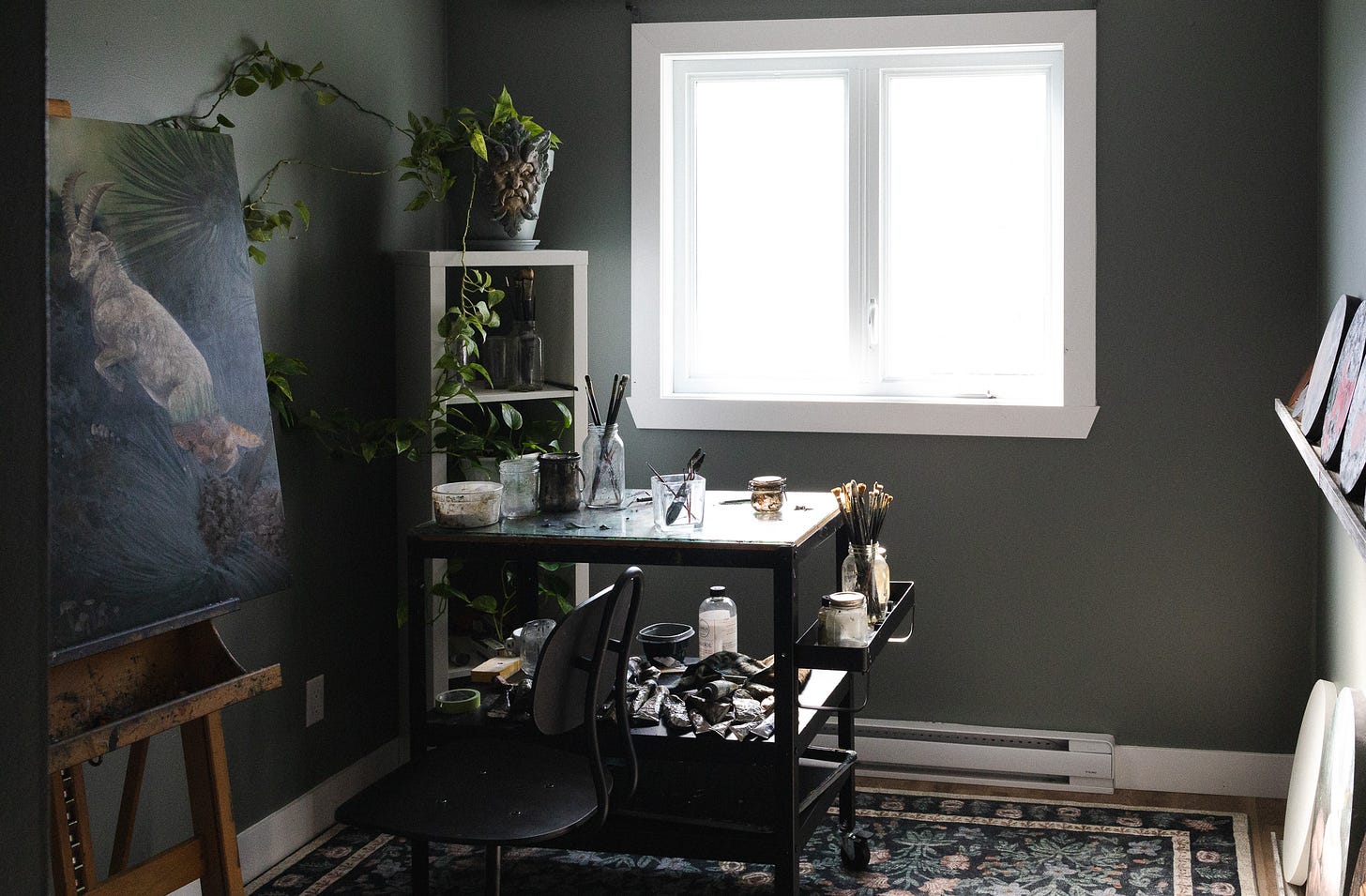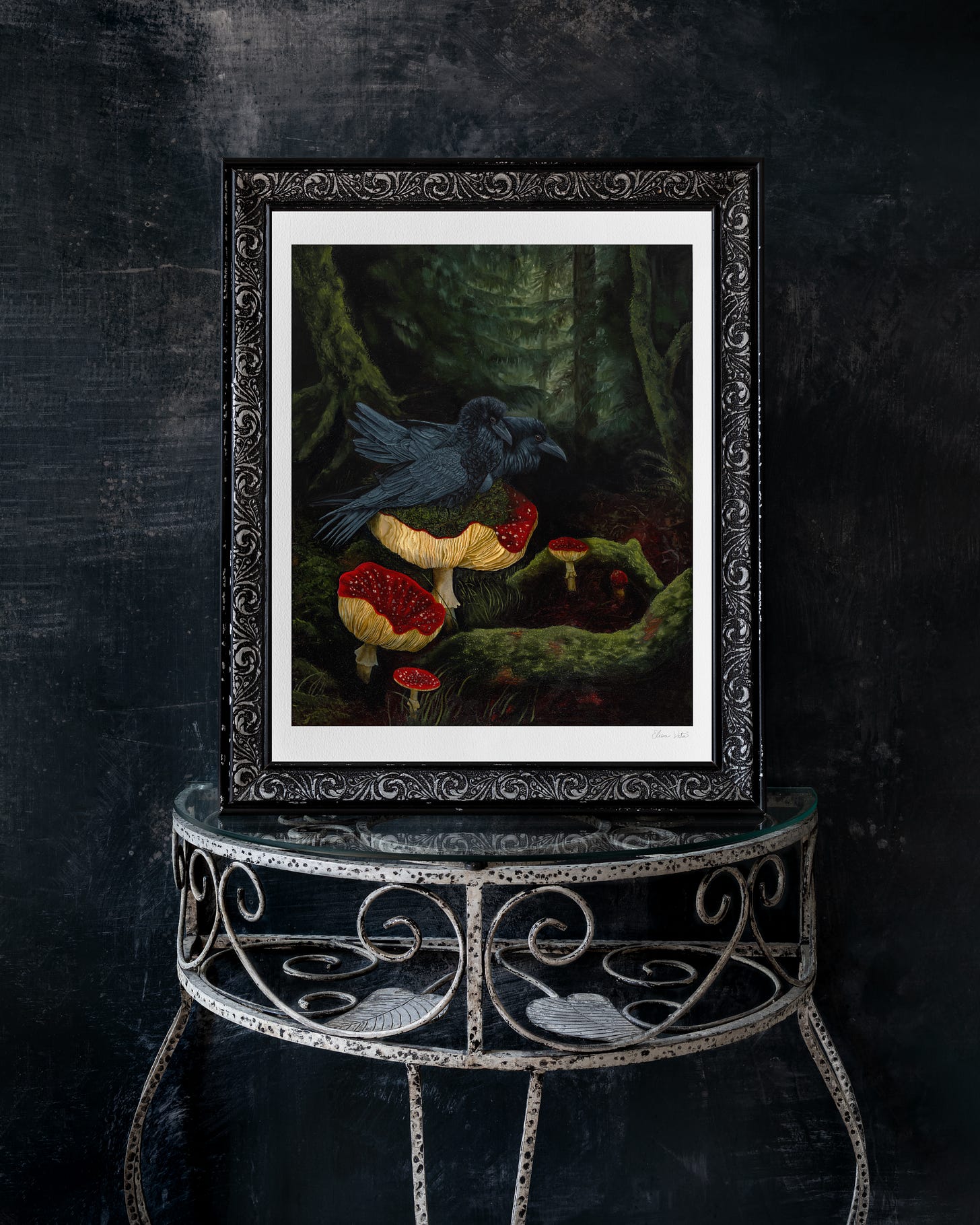Altars & Artists: Elisa Vita
Interview 04 - spectres and hauntings, natural fiction, and the woods as a psychological space
Welcome to Altars & Artists, a monthly interview series divining the poetry of artists' spaces. Inspired by Gaston Bachelard’s book "The Poetics of Space" and Virginia Woolf’s extended essay "A Room of One’s Own", Altars & Artists delves into the creative spaces of contemporary artists to reveal the intimate worlds they operate within.
If you enjoy this series, please consider becoming a paid subscriber—doing so unlocks an extended cut of each interview, including a prompt made especially for you by the guest. Your contribution also keeps Ruminations running & this writer at her desk ❧
New to this series? Be sure to check out the intro post below:
Please welcome our October Altars & Artists guest—Elisa Vita ❧
Elisa Vita is a Montreal-based oil painter who crafts mythic tales of the deep, dark woods. She draws from fairy tale imagery, so often relegated to the world of children’s books, and explores its imaginative potential in a contemporary fine art context. For Vita, the woods act as a psychological space where the laws of perspective and lighting don’t quite apply. These subtle technical subversions lend a tension to her otherwise meticulously rendered subjects, be(wild)ering the viewer’s gaze and prompting them to get lost in the painting. From this place of disorientation, flora, fauna and fungi can bewitch passersby. Vita has graduated with a BFA in Painting and Drawing from Concordia University (2017) and an MFA in Visual Art from York University (2023). She continues to independently study European folklore, mycology and ecology.
Questions & Curiosities
Welcome to Ruminations Elisa, it’s such a pleasure to have you here. Could you please begin by telling us a bit about yourself?
EV: It’s such a pleasure to be here! Thank you for inviting me. I’m a visual artist who paints flora, fauna, and fungi. I view art-making as a magical practice, a witchery of sorts.
Your work is beautiful, dark, and incredibly detailed—They Move Like Smoke is a personal favourite. The woods are a recurring motif in your work and you muse that this deep, enchanting place exists within your heart of hearts. When did you first connect to this internal place? What led you to portray that inner world externally through art?
EV: Thank you so much for your kind words. My earliest memories of experiencing that sense of enchantment regarding the natural world are from early childhood. My grandparents had a cabin in rural Quebec. I can still remember the scent of pine needles baking in the sun. In the evenings, my mother would read my sister and me fairy tales on the balcony overlooking the forest. Some nights, we would be visited by what felt like hundreds of falling stars. I learned they were called fireflies, though we often pretended they were faeries.
There was a sense of eeriness and unease in that place too though. One of the walls between the washroom and the back door was covered in fanged and clawed taxidermy. I would always sprint past it, refusing to make eye contact. I’m no longer religious, but I was raised Roman Catholic. It seemed to me that if Jesus could rise from the dead then those creatures might too. Revenge was a common theme in the fairy tales; evil stepmothers were drowned for their cruelty, and evil stepsisters were forced to dance to death. Surely the animals being used as decor would want retribution.
When I was six, my grandfather died and the cabin was sold. It would later burn down. Still, the sense of magic inherent to that setting stayed with me. In school and in life, I often felt strange and was made to feel strange by others. It was a comfort to know that beauty and cruelty could exist in the same place. It was like that in the fairy tales, in my grandparents’ cabin, and in the forest itself. If I looked at life like a chiaroscuro painting or a story, then the hard and dark things could be enchanted too. Making art was a way of reinforcing that. I was shaping reality just as much as I was escaping it.
You describe your paintings as “natural fiction”, reflecting that your work allows you to create impossible ecosystems of flora and fauna. I’d love to know what your process is for bringing each of these scenes to life, and if the spaces you work within, your altars, play a role in that process.
EV: The paintings always begin as a haunting. I’ll notice something flitting in the corner of my mind’s eye and if I try to pin it down too quickly, the image ends up being nothing more than a butterfly preserved behind glass. Lovely but lifeless. So, I let the spectre of the painting come to me. Sometimes it disappears back into the ether. Other times, it gets louder and more solid—disruptive even. When I can clearly make out its silhouette it’s time to get to work.
I start by pouring through my library of reference photos, many of which I’ve taken during woodland walks. The spectre and I will spend a few days going back and forth, moving and warping elements into a collage until we’re both satisfied that the skeleton of the painting is complete. The sense of being haunted evaporates once the painting’s composition has been decided. Colour and lighting choices are made in solitude, once my brush finally meets the panel.
My altars play a crucial role in the creation process. From start to finish, I need to be porous to get the work done. Liquid, almost. That’s how the boundaries between the “natural” and the “fiction”, or the real and the imaginary, get blurred. The spaces I occupy act as protective cauldrons. It’s best to flow in the safety of a considered container. Otherwise, the degree of sensitivity required to execute the paintings may lead me astray.
Wow, what a beautiful explanation of your ideation process. I’d love to spend some time exploring the spaces where you bring these spectres to life.
EV: The collaging/ideation phase of my process takes place in the living room. I also sign and ship my prints from there. The wall against my desk is painted the blackened green of a nocturnal wood. On either side of it are Tiffany-esque lamps that I’ve collected or have been gifted over the years. I’ve adored the colourful glow of that lamp style since childhood, and later on, learned that they were tied to the art nouveau movement. Art Nouveau's emphasis on the natural world, ornamentation, and romance in the face of industrialization mirrors the ethos behind my own work. I love how the aesthetic elements we feel drawn to at a young age can foreshadow what will become the larger themes of our lives.
Once I’m done collaging, I move into my studio. I wanted the tiny space to feel fresh and expansive, so I painted it a mid-value blue with green undertones. The colour makes me think of a cool, misty cliff face. It’s also desaturated enough not to compete with whatever palette I’m mixing. I live in the city and the view from my studio is of a row of buildings. In the Montreal winter, it ends up just being grey-brown buildings amidst grey-brown snow and grey-brown concrete; a hue that’s decidedly less appealing than that of my walls. I opted to cover the window with frosted vinyl as a result. This way it feels like the studio exists outside of space altogether. Greenery is energising to me, so I have pothos vines trailing behind my easel. It gives me that vital feeling of being outdoors while I work.
“I’ll notice something flitting in the corner of my mind’s eye and if I try to pin it down too quickly, the image ends up being nothing more than a butterfly preserved behind glass. Lovely but lifeless.”
In your artist statement, you say “Painting is a bloody endeavour. It marks my body as my body marks the panel. As such, it feels like a sort of ritual exchange, a form of witchcraft.” Can you tell us more about this ritual exchange?
EV: My paintings are a channelled expression of something outside of me just as much as something within. I refer to the deep, dark woods as a psychological space, but it’s also archetypal or mythological. If my artwork resonates with someone, it’s because that space lives in them too. I just provide a doorway through my craft.
I’m an instinctively wary person. I would not have chosen the precarious life of an artist had I not felt utterly compelled to. This arrangement feels contractual. I implicitly owe my work time and devotion. That’s true not just of the physical art objects I create, but of that mythological wood itself. It’s like being a priestess of sorts. I give myself to the work and it sustains me in turn.
I love the idea of sharing an internal space with others who resonate with your work; we must all subconsciously subside in those deep, dark woods.
Although each artist's space is unique to their needs and work, I wondered if your MFA in Visual Art influenced the way you interact with your studio space. Do you maintain certain artistic practices from your days as a student, or are there approaches and attitudes you’ve departed from since?
EV: I’m grateful to grad school for providing me the opportunity to explore the theoretical frameworks surrounding my art. That being said, I was creatively paralysed and emotionally wrecked for over a year after completing my MFA. I would critique every image that came to mind before it had even formed fully, trying to gauge its academic value, whether it might qualify for government grants, public gallery shows, etc. Eventually, I was questioning if there was any point to my work or to me at all.
Directing my attention to the physical space of my home and studio was a way of grounding back into my body and intuition, so I could hear the spectres of the paintings again. Eventually, I made the conscious decision to focus on pursuing my work independently and sharing it directly with an audience. I no longer wanted to consider how I might conform to whatever the fine art world’s current thematic and visual trends might be. I’ve felt truly excited by my practice since. Nurturing the physical spaces I occupy remains a huge part of that.
“I refer to the deep, dark woods as a psychological space, but it’s also archetypal or mythological. If my artwork resonates with someone, it’s because that space lives in them too. I just provide a doorway through my craft.”
Who, or what has influenced your artistry? How are they honoured in your space and work?
EV: A very present and ongoing influence on my artistry is my dear friend, Alyssa Thorne. She’s a still-life sorcerer, sculpting props and then photographing them to create little worlds. Her attention to detail is hugely inspiring to me. She understands that the curve of a leaf or the tilt of a petal is its own language. Shift the form one way or another, and suddenly the image might say something else entirely. I’m nowhere near mastering her degree of expressiveness when it comes to those details, but I aspire to with every new painting.
The imagery in my work as well as my esoteric worldview is hugely influenced by my Italian heritage by way of my maternal and paternal grandparents. They immigrated to Canada after the Second World War. Like most Italian immigrants at the time, they came from rural areas that did not have the same employment opportunities as the country’s more industrialised cities. The isolated nature of these communities meant that many folk beliefs were able to survive through both Christianisation and industrialisation. My grandparents carried those beliefs with them, even as most everything else was left behind.
I have a very literal altar that honours my grandparents and my other ancestors. It’s a tiny iron table composed of curling lines and leaves. My great-grandfather made it while running his own metal works business in Montreal. I photograph my fine art prints on that altar as a nod to the artistry of the past, as well as to his scrappiness and entrepreneurial spirit. It feels a little surreal to capture my artwork on this family heirloom and then share it online for my own small business. It’s as though time is melting into a circle. For me, disseminating the work is just as important a part of the creative cycle as making it is.
Thank you so much for sharing your altars and creative journey with us, Elisa! Before we move on to the next segment for our paid subscribers, can you share anything about your current or upcoming projects with the readers of Ruminations?
EV: I’m currently working on a series of small circular paintings to be released for sale in mid-November. A blog exploring art, ritual, and enchantment is also in the works. It will be accompanied by a podcast, for those who prefer to have me read to them.
The best way to be informed when these go live is to join my mailing list. The sign-up form is in the footer of my site.
Prints available here: https://elisavita.com/collections/prints-for-sale
Website/Email sign-up: https://elisavita.com/
Paintings: https://elisavita.com/collections/paintings
Instagram: @elisavitafineart
Before you leave us with your creative prompt, we have some rapid-fire questions for you. So! Without further ado…
Keep reading with a 7-day free trial
Subscribe to Ruminations to keep reading this post and get 7 days of free access to the full post archives.




